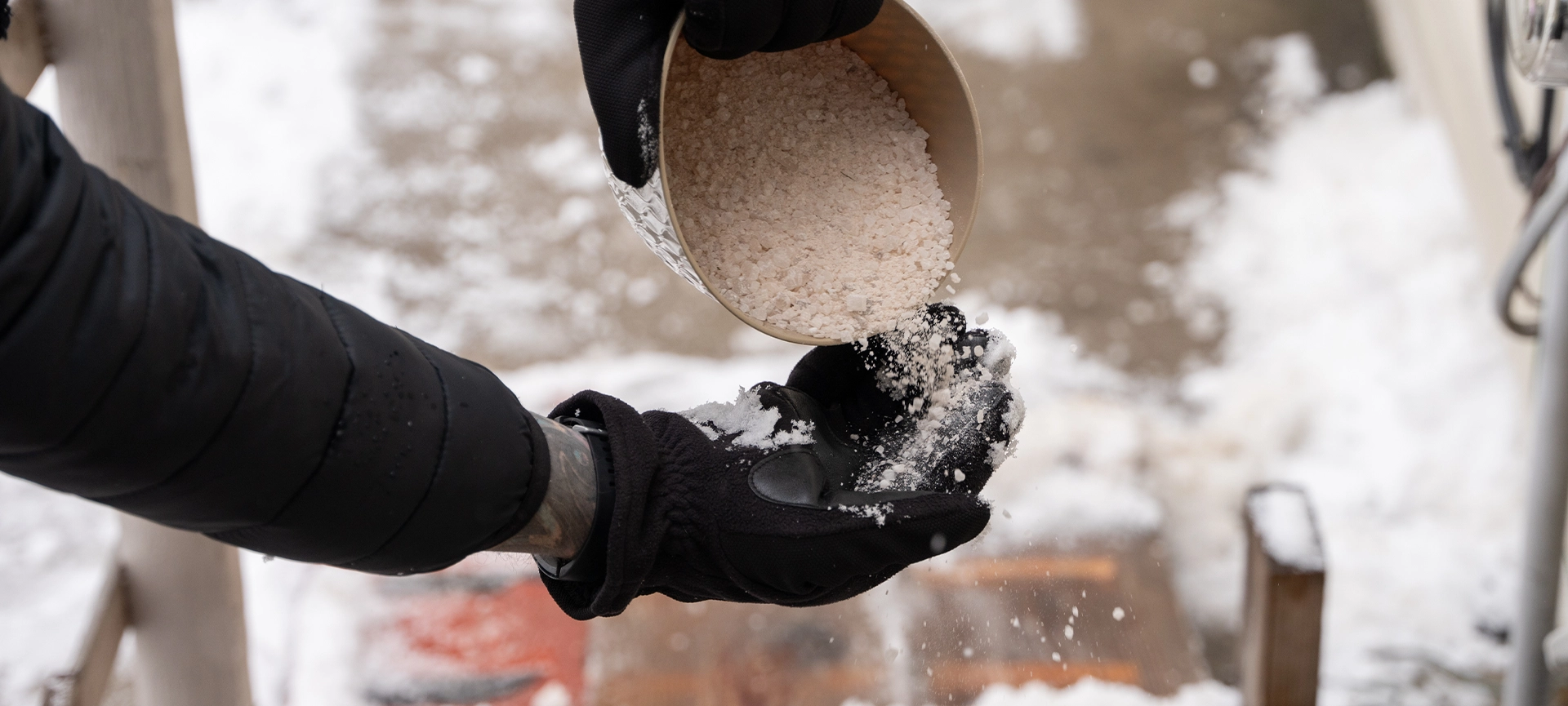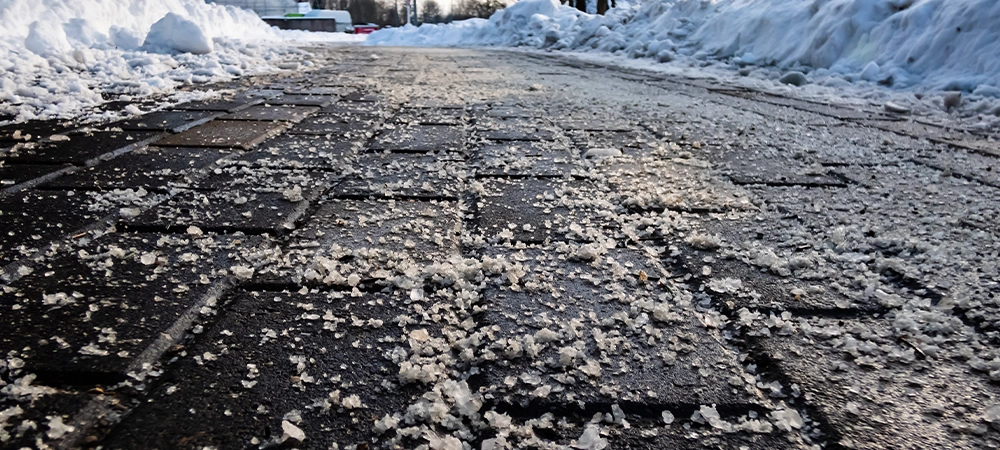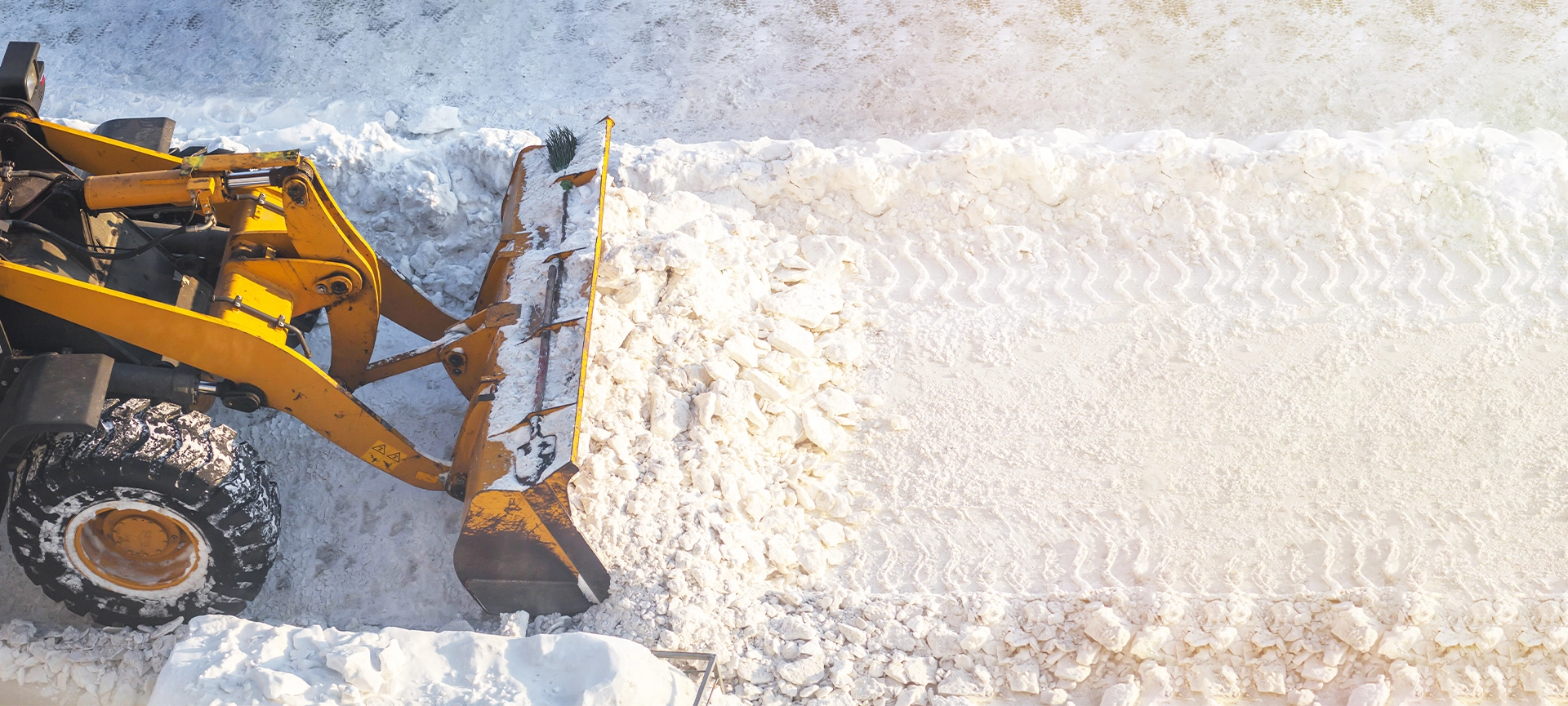
Melting ice with rock salt helps in a pinch, yet it addresses only today’s hazard. Commercial properties with heavy traffic, complex layouts, and liability exposure need a broader winter strategy that prevents ice before it forms, measures surface temperatures, and keeps records for insurance.
This guide explains when de-icing is fine, when it falls short, and how full-service ice management safeguards people, budgets, and reputations.
Related Article: How Snow Accumulation Affects Your Building’s Structure Over Time?
Why De-Icing Is Just the First Step
De-icing reacts after ice bonds to pavement. Salt lowers the freezing point, buys traction, and simplifies shovelling. That quick fix is affordable and familiar, so many facility managers start and stop there.
However, salt has limits:
- Dilution: Meltwater washes brine away; refreeze can return within hours.
- Temperature thresholds: Sodium chloride loses potency below –9 °C.
- Surface damage: Repeated applications corrode metal and stain concrete.
Without preventive measures, ice cycles repeat, labour climbs, and tenant complaints rise. A proactive program addresses root causes, not symptoms.
Related Article: Top 7 Mistakes Businesses Make with Snow and Ice Management
Signs Your Site Needs Full-Service Ice Management
Full-service ice maintenance or management means pre-treatment, mechanical clearing, on-call monitoring, compliance logs, and risk reviews. Consider upgrading if you notice these triggers:
- High footfall or 24-hour operations – Malls, hospitals, and logistics hubs cannot close while ice melts.
- Multi-level surfaces – Ramps, steps, loading bays, and shaded courtyards freeze unevenly.
- Past slip claims – One payout often costs more than a season-long contract.
- Sensitive materials – Parking decks over occupied space cannot absorb chloride runoff.
- Strict lease language – Some commercial leases require documented ice control within set timelines.
Failing to meet any of the above exposes owners to fines, lost rent, and brand damage.

Key Components of Comprehensive Ice Management
A complete program bundles several services under one point of contact:
- Site mapping and sensor placement: Technicians chart drainage, slope, and heat loss, then install wireless temperature probes.
- Anti-icing: Brine or calcium chloride is applied before storms, preventing ice from bonding to pavement.
- Mechanical snow clearing: Plows, brushes, and blowers remove bulk snow quickly, reducing melt-freeze cycles.
- Post-storm audits: Crews re-inspect hot spots and spread treated sand where traction is still low.
- Digital reporting: Time-stamped photos and treatment logs provide legal proof of diligence.
This bundle keeps surfaces consistently safe while giving managers data to defend their due diligence.
Risks of Relying Solely on Reactive De-Icing
Leaving ice control to post-storm salt runs looks frugal on paper, yet the true price shows up in injuries, asset damage, and compliance fines.
- Liability spikes: Slips most often occur between scheduled de-icing rounds—late evenings, early mornings, or after a sudden temperature drop. A single claim can top $20 000 in legal fees, medical costs, and lost productivity, far outstripping the price of preventive service.
- Insurance premiums rise: Multiple incidents flag your site as high-risk. Carriers respond with premium hikes or policy exclusions, and many now demand digital treatment logs; missing entries can void coverage altogether, leaving owners to shoulder payouts.
- Structural wear: Chloride crystals draw moisture into concrete, then freeze and expand, causing cracks and spalling. Steel handrails, rebar, and door frames corrode faster, too, reducing service life and inflating capital-repair budgets.
- Environmental penalties: Excess salt flows into catch basins and streams, killing roadside vegetation and altering water chemistry. Several Canadian municipalities levy fines (often $1 000–$5 000 per event) when runoff tests exceed chloride limits.
Across five winters, the extra repairs, insurance surcharges, and fines can push a “cheap” reactive strategy 25 % above the cost of a comprehensive, documented ice-management contract before factoring any lawsuit settlements.
Related Article: How to Audit Your Property for Winter Safety Before the First Snowfall
Cost–Benefit Comparison: De-Ice vs Full-Service
Understanding numbers clarifies the upgrade decision.
| Cost Centre | Reactive Only | Full-Service Program |
| Salt and labour per event | Low | Included |
| Emergency call-outs | High | Minimal |
| Slip claim reserve | Significant | Low |
| Long-term surface repair | High | Lower |
| Insurance premium trend | Rising | Stable or falling |
A five-hectare retail lot averaging 20 freeze events can spend 25% less overall with full-service, because bulk contracts secure material discounts, reduce call-outs, and prevent litigation.

Quick Savings Checklist
- Lock winter rates in summer.
- Choose liquid anti-icers over granular salt; liquids stretch coverage.
- Source eco-certified products to avoid runoff fees.
Choosing the Right Ice Management Partner
A credible contractor should provide:
- Proof of insurance at or above industry norms.
- 24/7 dispatch with GPS-tracked fleets.
- Trained operators certified in anti-icing techniques.
- Transparent reports are delivered after every visit.
- Scalable resources to handle multi-site portfolios.
Request references from properties similar in size and exposure. Walk the site pre-season, agree on trigger temperatures, and set service timelines to avoid gaps in coverage.
Sustainable Practices and Compliance
Municipalities across Canada are tightening chloride runoff limits. Progressive contractors adopt:
- Brine makers that blend precisely measured saltwater on site, cutting product volume by up to 40%.
- Pre-wetted salt that sticks to pavement, reducing scatter.
- Non-chloride blends for sensitive green spaces.
- Electronic spreader controls that log application rates for audit trails.
Compliance is not just green stewardship; it protects budgets from fines and supports corporate social responsibility goals.
Practical Next Steps to Stay Ice-Free
De-icing alone tackles today’s glare ice but leaves tomorrow’s risk intact. Review slip records, inspect drainage, and calculate the full cost of winter incidents. If emergency calls and insurance premiums keep rising, schedule a site audit with a full-service provider before the first frost.
A proactive contract delivers safer walkways, steadier budgets, and peace of mind for everyone who sets foot on your property.
Book your free winter safety audit now. Our team delivers a detailed ice management plan within 48 hours so you can focus on business, not black ice.



